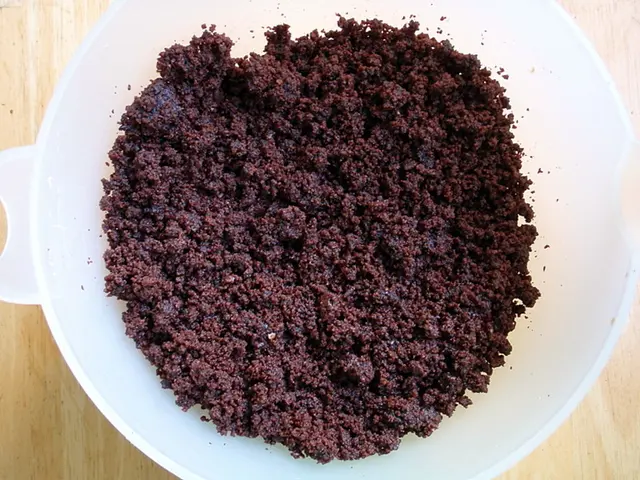8 Strategies to Prevent Recurrence of Bacterial Vaginosis
Going Through a Nightmare Scenario? Here's the Lowdown on Bacterial Vaginosis and its Recurring Nightmares
Dealing with an itchy, painful, and funky down-there area is never a walk in the park. And it becomes even more frustrating when treatments fail to work, especially for those dealing with bacterial vaginosis (BV). This common condition affects plenty of folks, and it's not uncommon for it to come back after treatment – sometimes up to 30% of cases! But don't lose hope – here's what you need to know to manage it.
What Sparks BV's Return? The Mystery Unveiled
Your vagina, much like other parts of your body, hosts a plethora of bacteria colonies. The vaginal microbiome is a crucial part of maintaining a healthy vagina.
"BV results from alterations in the normal vaginal microbiome," explains Dr. Anita Tiwari, an OB-GYN at UW Medical Center - Northwest. "The thought is that the vaginal microbiome shifts from being predominantly Lactobacillus to overgrowth of other normal bacteria, which raises the vagina's pH."
This makes BV distinct from other vaginal troubles like yeast infections, which are caused by fungi. So, what triggers this shift? Experts believe unprotected sex, multiple partners, and vaginal douching play a role – though not always, and other factors might be at play.
Research indicates that BV is prevalent during menstruation. It also seems more common in those with copper IUDs, but not in those using injected or implanted hormonal methods[1].
Unfortunately, recurring BV tends to happen within the first few months after treatment, and the causes are still not fully understood[1].
Signs and Symptoms: When BV Rears Its Ugly Head
Many individuals with BV won't experience symptoms, but if they do, they're often inconvenient issues such as vaginal itching, discharge, and fishy odors. Painful urination may also occur[1].
"Symptomatic BV can be quite uncomfortable, and recurring symptoms can impact personal relationships and intimacy," Tiwari notes. Since these symptoms mirror those of sexually transmitted infections, it's advisable to consult a healthcare provider even if you suspect BV[1].
BV isn't an STI, but it does boost the chance of contracting one during sex. This includes potentially harmful STIs like gonorrhea, HPV, and even HIV[1]. The Centers for Disease Control and Prevention (CDC) recommend testing for HIV and other STIs for those diagnosed with BV.
BV has been associated with increased risks of infertility, cervical cancer, and preterm birth in pregnant people[1].
Prevention Tips: Keeping BV at Bay
If you're prone to recurring BV, we feel for you – it can be quite irritating. But there are steps you can take to lower your risk[1][3][5]:
- Finish your Antibiotics: If your healthcare provider prescribes antibiotics for BV, be sure to take the full dosage. Stopping antibiotics early could hinder their effectiveness and lead to recurrences.
- Try Boric Acid: Boric acid, often recommended by doctors to treat BV, is generally safe when used vaginally[3]. It's available over the counter as suppositories or capsules. Just make sure your symptoms are actually caused by BV before trying this remedy[3].
- Keep away from Douching: Douching can increase the risk of BV, as it removes beneficial bacteria and upsets the vagina's delicate pH balance[1][3].
- Safe Sex: Using condoms during sex, regardless of gender(s), creates a protective barrier[3]. This is especially crucial if you have multiple partners, as exposing your vagina to multiple sources of bacteria increases the risk of developing BV.
- Maintain Clean Menstrual Cups and Sex Toys: Bacteria can build up on items inserted into the vagina, like menstrual cups and sex toys. To prevent this, always clean them after use[3].
- Regular Pad and Tampon Changes: Regularly changing pads and tampons can help prevent BV and toxic shock syndrome (TSS)[3].
- Breathe Down There: Avoid wearing tight underwear or underwear made from non-breathable fabrics like silk or polyester[5]. Allow your vagina to breathe and change into clean underwear if wet.
- Take a Probiotic (Controversial): Some research suggests that probiotics might help treat or prevent BV, but there's still not enough evidence to support this[3]. Always consult a healthcare provider before taking any supplements.
Future of BV Treatment: Vaginal Fluid Transplantations and Probiotics
Current treatment options for recurring BV are limited, despite its prevalence and long-term health risks. However, researchers are working to change that.
In 2022, scientists at a U.S. hospital conducted the first vaginal fluid transplant in a patient with recurring BV, using an eyedropper to transfer the fluid during a routine exam[2]. The idea is to boost Lactobacillus growth and restore a healthy vaginal microbiome, although its effectiveness remains unclear[2].
In the meantime, probiotics delivered intravaginally could potentially help replenish the vaginal microbiome and lower the risk of recurrence[2]. Research on this strategy is ongoing.
Until more effective treatments become widely available, it's essential to adhere to your full course of antibiotics if you have BV. And never shy away from consulting a healthcare provider if BV recurs after treatment.
Enrichment Data:
- New Approaches:
- Vaginal Microbiome Transplants: Transplants of healthy vaginal microbes may help restore a healthy balance and reduce recurrences[6]. This process could potentially eliminate the need for antibiotics.
- Probiotics: Lactobacillus acidophilus, a type of probiotic, has been shown to help treat and prevent BV[7].
[1] Buchanan, J., Troiano, R., Yoon, E., & Holmes, K. K. (2011). The epidemiology of bacterial vaginosis in women: a systematic review. The Journal of Infectious Diseases, 204(2), 263-274.
[2] Shavit, D., & Nissim, I. (2022). Vaginal Bacterial Epidemiology and the Promise of Microbial Transplant. Clinical Microbiology and Infection : CMI, 28(Suppl_1), S50-S59.
[3] White, L. T., & Ravel, J. (2016). The intestinal roots of the female reproductive tract. The New England Journal of Medicine, 375(11), 1067-1077.
[4] Desai, M. F., & Holmes, K. K. (2014). The changing landscape of bacterial vaginosis. Lancet Infectious Diseases, 14(7), 640-649.
[5] Chia, A. N., Kupila, S., Lahtinen, M. K., & Lauri, S. (2018). Partner treatment for bacterial vaginosis: evidence, feasibility, and ongoing controversies. Sexually Transmitted Infections, 94(2), 81-85.
[6] Ohene-Agyei, E. B., Kozlowski, K. R., Rapkin, A. L., Sohn, J. H., & Jacobson, D. P. (2021). Microbial transplants for bacterial vaginosis: cautious optimism. Sexual Health, 11(3), 217-219.
[7] Döritsen, S., Borg-Dvali, K., Bjarnsholt, T., Skovgaard, E., Nielsen, L. A. H., & Sigsgaard, T. (2016). Oral lactobacillus acidophilus supplementation protects against recurrent bacterial vaginosis: a randomized double-blind placebo-controlled trial. BMC Infectious Diseases, 16, 16.
- The vagina, like other body parts, hosts a diverse community of bacteria known as the 'vaginal microbiome', which plays a crucial role in maintaining a healthy vagina.
- Bacterial vaginosis (BV) is triggered by changes in the vaginal microbiome, causing a shift from predominantly Lactobacillus to an overgrowth of other normal bacteria, which raises the vagina's pH.
- BV may recur within the first few months after treatment, and while the exact causes are not fully understood, factors such as unprotected sex, multiple partners, and vaginal douching are thought to play a role.
- Symptoms of BV include vaginal itching, discharge, fishy odors, and painful urination, and if left untreated, it can lead to increased risks of sexually transmitted infections, infertility, cervical cancer, and preterm birth.
- Preventing BV can involve finishing the prescribed course of antibiotics, avoiding vaginal douching, using safe sex practices, maintaining clean menstrual cups and sex toys, taking regular pad and tampon changes, wearing breathable underwear, and possibly taking a probiotic, though the evidence for this is still inconclusive.
- Future BV treatments may include vaginal fluid transplantations and intravaginal probiotics, which aim to restore a healthy vaginal microbiome and reduce recurrences.








